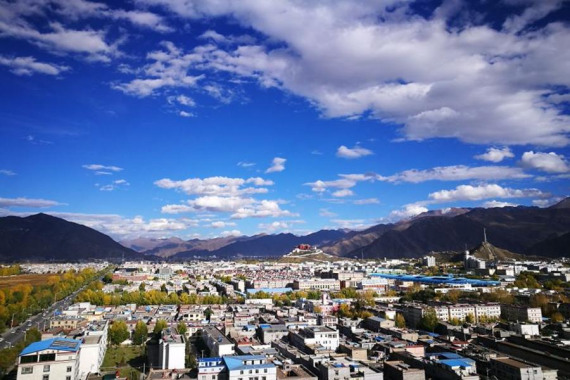
The intoxicating blue sky in China's Tibet autonomous region. (Photo/Provided to China Daily)
An environmental protection project in Tibet is taking shape, and beginning to bring about improvements, the Chinese Academy of Sciences (CAS) announced Wednesday.
"Tibet has one of the best quality environments in the world," said Wang Haizhou, vice chairman of Tibet autonomous regional government.
The State Council in 2009 approved the "Plan for Ecology Safety Barrier Protection and Construction in Tibet (2008-2030)," to further improve the environment in this southwestern region.
To evaluate the implementation of the plan, CAS issued an assessment report Wednesday on the progress achieved between 2008 and 2014.
According to the report, the plateau environmental system in Tibet is generally stable and the vegetation coverage has been on the rise.
Areas suffering from desertification have decreased by 107,100 hectares.
Measures to return grazing land to grassland have also been lauded and have had the upshot of increasing the incomes of farmers and herdsmen.
There has been a significant rise in the use of clean energy to support farming and breeding while the lives of farmers and herdsmen have considerably improved. The usage of new clean energy has reached 65.6 percent, mitigating damage to forest and grasslands.
Tibet's nature reserve area now covers 413,700 square kilometers. The area of wetlands under protection is now 4.31 million hectares, or 65.98 percent of all wetland in Tibet. Rare animals and plants are also being effectively protected, the report said.
"The quality of the water, air, soil and environment atop of the Tibet Plateau remains in good condition," Wang said.
Wang added that the water quality of many main rivers and lakes, such as the Yarlung Zangbo River and Namtso Lake, are at Grade I or Grade II, the top two water quality levels.
The air quality in major cities and towns is mostly good, and most of the forests, grasslands, wetlands and wildlife across Tibet are still pristine, Wang said.
According to CAS vice president Zhang Yaping, for the project CAS researchers took three years, inspected over 10 major zones, collected about 1,300 samples from three different areas and 20 monitoring sites and reached the conclusions stated in the report.
CAS also analyzed remote sensing data in three periods since 1990 and studied environmental changes in Tibet over the past 20 years.


















































